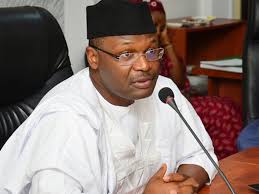Finally, IMF approves N1.2trn emergency support for Nigeria

.Commends Nigeria for ‘immediate action’ against COVID-19 crisis

Finally, the executive board of the International Monetary Fund (IMF) has approved the $3.4 billion (N1.227 trillion) requested by the Nigerian government for emergency support.
READ ALSO: Coronavirus: Udom cancels random testing, says it’s waste of resources
The fund on Tuesday explained that the board met to discuss Nigeria’s request for emergency support under the rapid financing instrument.
It is, however, worthy of note that the $3.4 billion when converted to the Nigerian currency, Naira, at the Central Bank of Nigeria (CBN) official rate of N361/$1 amounted to over N1.227 trillion.
However, the approved $3.4 billion represents the total Special Drawing Right (SDR) Nigeria holds with the IMF.
The disbursement is also the highest to be approved for any African nation so far.
A statement released by the IMF announcing the approval said the financial support will “help limit the decline in international reserves and provide financing to the budget for targeted and temporary spending increases aimed at containing and mitigating the economic impact of the pandemic and of the sharp fall in international oil prices”.
Mitsuhiro Furusawa, Deputy Managing Director and Acting Chair of the IMF Executive Board, commended the “immediate action” taken by the Federal Government to respond to the COVID-19 crisis.
“The short-term focus on fiscal accommodation would allow for higher health spending and help alleviate the impact of the crisis on households and businesses,” he said.
“Steps were taken toward a more unified and flexible exchange rate are also important and unification of the exchange rate should be expedited.
“Once the COVID-19 crisis passes, the focus should remain on medium-term macroeconomic stability, with revenue-based fiscal consolidation essential to keep Nigeria’s debt sustainable and create fiscal space for priority spending.
“Implementation of the reform priorities under the economic recovery and growth plan, particularly on power and governance, remains crucial to boost growth over the medium term.”
Furusawa said the emergency funding will provide the liquidity needed to respond to an urgent balance of payments needs.
“Additional assistance from development partners will be required to support the government’s efforts and close the large financing gap. The implementation of proper governance arrangements—including through the publication and independent audit of crisis-mitigating spending and procurement processes—is crucial to ensure emergency funds are used for their intended purposes.”
The IMF said it stands ready to “provide policy advice and further support as needed”.
Meanwhile, Nigeria’s total debt stock comprising the debts of the Federal Government, 36 states and the Federal Capital Territory (FCT) as at December 2019 stands at N27.401 trillion compared to N26.215 trillion stood at September 2019.
This was according to the figure obtained from the official website of the Debt Management Office (DMO).
However, while comparing the September 2018 figure of N25.701 trillion, showed that in the 12 months period to September 2019 the Total Public Debt grew by 16.88 per cent.”
The Director General of DMO in an earlier speech this year said that the total public debt as at September 2019 includes promissory notes in the amount of N812.650 billion which had been issued to settle the FGN’s arrears to oil marketing companies and state governments under the promissory programme approved by the Federal Executive Council and the National Assembly.
Speaking specifically about the borrowing and how it helped bring Nigeria out of recession, Patience Oniha, the DMO boss, noted that “borrowing came in to fund the budget which included capital projects so when you finance capital projects, you create an entire economy around that in terms of employment, in terms of materials that you buy, in terms of what happens in the environment, so there are vendors selling all sort of things so that is the description.
“We are talking about the multiplier effect of borrowing to finance capital infrastructure and what we generate.”
Consequently, China and G-20 countries have agreed to give debt relief to the poorest countries in the world which are classified as IDA countries by the World Bank.
At the just-concluded April 2020 virtual Spring meetings of the World Bank and International Monetary Fund (IMF), David Malpass, the World Bank president, said beginning from May I, there would be debt relief.
“IDA countries will have bilateral debt relief beginning May 1. That way, they can concentrate their resources on fighting the pandemic and its economic and social consequences,” he said.
“I take note that in the G-20 meetings, China is supporting the international agreement to allowing moratorium of debt repayments by IDA countries if they ask for forbearance.
“That’s very important because China is one of the biggest creditors and their participation in that effort is important and was very welcome.”
Countries under the International Development Association (IDA) are those with per capita income below an established threshold. The 2020 threshold is $1,175.
Countries, such as Nigeria and Pakistan, are IDA-eligible based on per capita income levels and are also creditworthy for some IBRD borrowing. They are referred to as ‘blend’ countries.
A moratorium is the suspension of debt repayments while debt relief is the reorganisation of debt in any shape or form so as to provide the indebted party with a measure of respite, either fully or partially.
Malpass said a system will be set up to monitor how developing countries utilise the funds made available by the debt relief.
“So if the government saves money by not paying creditors, there is an expectation that they use it for health, education, economic rebuilding, jobs and concrete ways to help the people of their country,” he said.
“There is also within the debt relief initiative, the idea that there will be monitoring and assessment of the debt sustainability of poor countries.
“That process itself will amount to transparency. That’s going to change the way that countries have been lending into the developing world and it will improve it substantially and there will be a big benefit even to the creditors.
“It’s not the best system for creditors to be making non-transparent loans into poor countries and this is going to improve the system.”
He also said the process will also ensure that developing countries get more grants and concessional loans.
The details of the debt relief agreement have not yet been made public.








